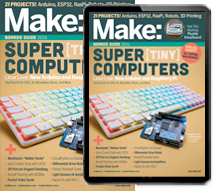






Fab-Lab.eu
- IoT OCTOPUS board with ESP8266 microcontroller, BME680 gas/environmental sensor, two Grove connectors for analog and I2C and USB
- Sensirion SCD30 CO2 sensor and Feather wing with pre-soldered headers
- Two RGBW NeoPixel LEDs on board
- Compatible with the Arduino IDE, program using ArduBlocks
- Wearable
- No soldering required to start
- Requires micro-USB Cable (not included)
- Quickstart Guide
This badge provides the basic components for a CO2 monitoring device that works as a CO2 Traffic Light. By reading CO2 levels and displaying the reading as easy-to-understand colors (green/yellow/red), this device can be used to measure proper ventilation indoors, which in turn can help reduce the risk of the spread of Covid-19 and also warn of poor air quality due to wildfire smoke. Visit our makezine.com/fresh-air page for more info about this project.
The custom OCTOPUS board, based on the ESP8266 chip, was designed by Fab-Lab.eu in Germany. The IoT Octopus board offers a lot of flexibility in selecting components such as different displays, sensors, power or networking options.
This kit was created to help schools during COVID19 to ventilate classrooms, which reduces the number of potential infected aerosols. This is a great DIY project for pupils/students to learn about STEM/MINT. This is not a life-saving, nor a medical device, as a kit it comes without certification. We recommend to calibrate the sensor in fresh outside air before use.
It comes an graphical programming extension to the Arduino(TM) IDE - Ardublock, we build any block specifically for IoT use cases plus blocks for CO2 monitors (you can calibrate the sensor, run a embedded web server presenting the data on your phone, or you can connect it to even more complex things like TheThingsNetwork(TM) or via MQTT(TM) to a grafan(TM) dashboard).
What is carbon dioxide?
Carbon dioxide (CO2) is a colorless, odorless, non-flammable gas that naturally occurs in the atmosphere. CO2 is produced by body metabolism and is a normal component of exhaled breath. It also results from the burning of fossil fuels and natural sources such as volcanic eruptions and wildfires. CO2 levels in outdoor air typically range from 300 to 400 ppm (0.03% to 0.04%) but can be as high as 600-900 ppm in metropolitan areas. Although it is most commonly present as a gas, CO2 can also exist in a solid (dry ice) form. CO2 levels in a conference room, or in a classroom will rise significantly when the door closes and people begin talking and respiring.
What are the health effects of carbon dioxide?
CO2 is considered to be minimally toxic by inhalation. The primary health effects caused by CO2 are the result of its behavior as a simple asphyxiant. A simple asphyxiant is a gas which reduces or displaces the normal oxygen in breathing air. Symptoms of mild CO2 exposure may include headache and drowsiness. At higher levels, rapid breathing, confusion, increased cardiac output, elevated blood pressure and increased arrhythmias may occur. Breathing oxygen depleted air caused by extreme CO2 concentrations can lead to death by suffocation.
Can you Detect CO (carbon monoxide) with a CO2 Detector?
The answer is no. CO2 detectors often use infrared sensors to detect levels of gas, while CO sensors mainly use electrochemical sensors.

